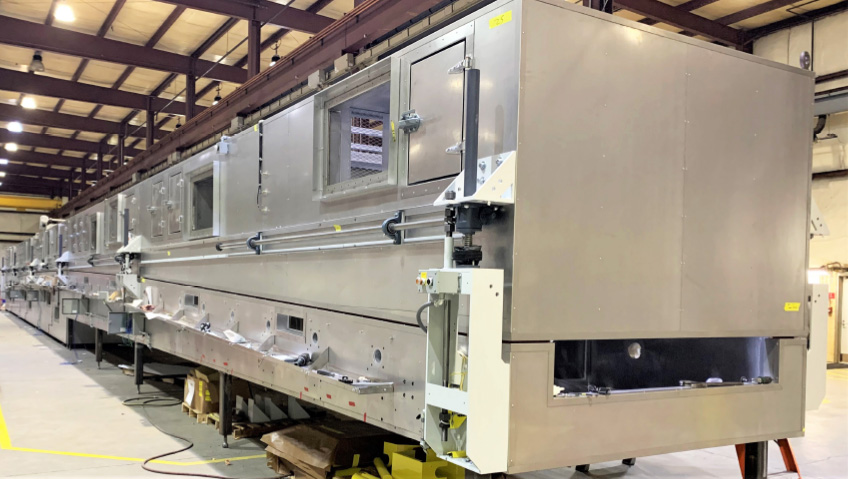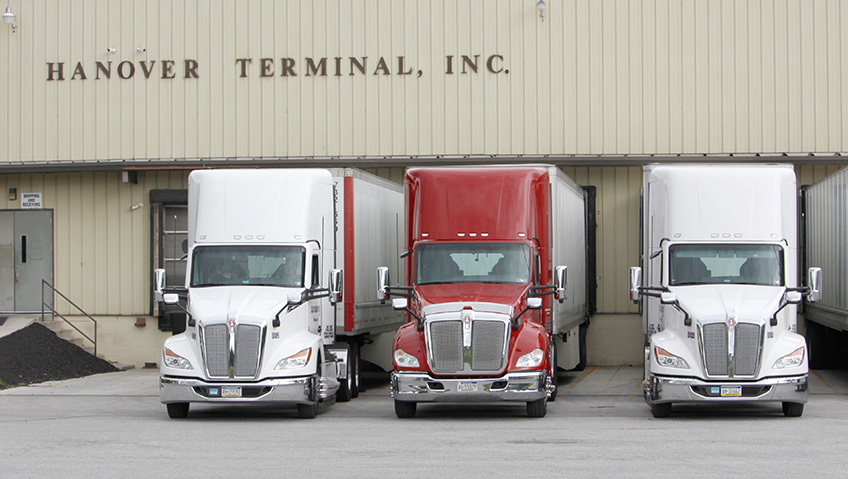Taking great pride in workmanship is a top priority for ASI, a company with more than 35 years of experience in specialized drying, curing, and cooling solutions for both the U.S. and overseas.
These drying systems bring together the knowledge and abilities of a highly skilled manufacturing staff, including engineers and designers, all with rich technical know-how. With more than 30 highly trained machinists, welders, electricians, technicians, and craftsmen working at ASI’s Green Bay, Wisconsin-based 65,000-square-foot manufacturing plant, the facility can meet customer needs by operating on several orders concurrently thanks to its numerous manufacturing bays and cranes.
“It’s hard to capture all the industries our dryers are used in,” says President Angela Krueger. While the company doesn’t always know what product is going to be made due to proprietary information, she explains, “we do a lot in the fiberglass mat industry, and since about 2000, we’ve made a fiberglass mat dryer, which we call a through-air dryer, about every three to four years. These are the largest dryers we make, and can be as big as several rooms.”
With a width of about 17 feet and a height between 12 and 20 feet, this very large equipment takes up most of ASI’s manufacturing space. The company also does a lot of work for the battery industry, in particular with electrodes, anodes, cathodes, and separators, and is also currently working on a fiberglass mat proposal for flooring material.
ASI also works with adhesives and release liners used for labels, other applications in the energy storage area, and a number of specialty, proprietary products such as flexible printed circuit boards, thermal barrier applications, and filtration media.
“In a nutshell, the dryers that we manufacture are used for pretty much any kind of product in a continuous operation,” says Lead Engineer Jim Rechner. “It could be all kinds of industries. It’s more or less the drying concept we really focus on.”
Krueger herself is involved personally from beginning to end of a product and process, and enjoys being part of the sales cycle, which can last a year or more.
“It’s very exciting to work on a project that eventually sells and to see that come to reality on the shop floor,” she shares. “I find that very gratifying. We’re turning out several proposals every week, and it’s a good feeling when one sells and we can see the build and eventually the installation and producing products for a customer.”
As President of the company and a woman working in a traditionally male-dominated industry, Krueger also appreciates both the challenges and rewards inherent in her position.
“There are not a lot of women in tech in manufacturing,” she says. “I would love for there to be more women in manufacturing. I have two daughters, and I’m encouraging both of them to pursue some type of STEM career. It’s a very rewarding career, and you’re always learning something new.”
Krueger is always open to supporting and encouraging other women in the business while combatting stereotypes of the construction industry. “It would do a lot to bring up the possibility of getting into this field in middle school and high school,” she says. “As a society we talk about being a veterinarian, or a doctor or lawyer, and we don’t think about how things are made and how we can be part of that process. Getting people to think about that at a younger age would get more people, especially girls and women, into it.”
Times are changing for the better, however, and ASI is seeing those changes firsthand.
“I have seen a pretty dramatic and positive shift to more women being in the manufacturing fields,” says Matt Kartheiser, Assistant Shop Supervisor. “When I first started here 10 years ago it was kind of the way that it’s always been, but in the last three years or so with the recruitment efforts we’ve made at some of the trade shows, or at some of the welding colleges and technical schools, I will say I’ve seen a large explosion.”
While initially there might have been one or two women in a class of 30 to 40 men, just this last year, he says, it was split almost 50/50. “I don’t know if the schools are promoting the idea of going into a skilled trade versus a more traditional career, but there definitely has been a positive shift that way,” he says. “ASI in particular has always been open to either men or women working here; we welcome both.”
The company has had several women working on the floor who were “phenomenal,” he says, adding that ASI will continue to strive to even things out between the sexes, including forming a partnership with a local welding school to help spearhead that effort.
“That being said, it’s a sort of nontraditional path for a lot of women to follow,” says Krueger. “It’s nice to know there’s a way to encourage women and girls to even consider it or look at it, because I don’t think it’s traditionally brought up to them as they’re looking at their futures.”
Krueger herself has much to share about the time and positive experiences she’s had in the industry. “It can be stressful at times, but ultimately it’s a great career,” she says. “I love always having to learn something, and being curious and staying curious. You have to be comfortable not always knowing the answer, but being willing to find the answer.”
When it comes to future plans for ASI, the company has a lot on the go, including a return to trade shows after years of COVID cancellations. In an ongoing effort to push into more markets and get the company name out there while still providing a high level of product and service, this year ASI will be exhibiting at the Tape and Functional Film Expo in conjunction with the Silicone Expo in Detroit, Michigan.
“It’s a slow process, to grow,” says Krueger. “[Growth is] dictated by the workforce you can find and, of course, the economic climate. But we’re a bit insulated from the ups and downs because of our long sales cycle and long lead time. There’s some fluctuation, but we’ve held steady over the years and we’re trying to expand and grow a bit every year.”
On the manufacturing side, ASI’s biggest future plan is getting the next career generation established. “A lot of people at ASI have been here since the company was founded,” says Kartheiser. “With so many reaching retirement age, we do have a lot of big shoes to fill.”
This means ASI is looking forward to getting its next 30-year crew together, as within three to five years many of the founding employees will be retired or close to it. “We’re really excited to be moving ahead and getting the next generation of professionals and the skilled tradespeople to take the reins for the next several decades,” Kartheiser says.
Krueger defines it as a bit of a transition period, transferring valuable knowledge and skills down to the next generation, along with looking for ways to automate as much as possible.
“Automation is a big push in manufacturing, and it’s a challenge to bring it to our industry because all our equipment is custom-made,” she says. “There are some areas where we could possibly use some type of co-bot for welding, but we’re just starting to look into that. We have invested in new, higher performing capital equipment in the last few years, including a press brake and folder.”
Along with continuing to push forward with technological advances, ASI sets itself apart from competitors through its customer process, thoroughly analyzing what’s needed to develop a functional project.
“A lot of our competitors have a standard piece of equipment they put in line and say, ‘here you go, this will work,’” says Rechner. “It does work, but how we came to be is we looked at each process with the customer and came up with the best solution. Not a solution, but the best solution.”
Since ASI houses everything in one building and is involved in the process from beginning to end, it’s able to service customers to a level that competitors simply can’t.
“We really are a one-stop shop, versus some other OEMs or other manufacturers that might need to reach out to other organizations to put all the pieces together,” says Kartheiser. “ASI can do everything under one roof, and especially on the manufacturing side. Approximately 85 to 90 percent of every piece of equipment that leaves here is built by hand in-house, so we’re able to control our quality procedures and all of our quality checks much closer and to a higher degree than a lot of our competitors.”
Customers know there’s an individual with a face behind every product that’s built specifically for them, he adds. “We’re very proud of that. And being a local company and very family-oriented, we have very good relationships with our customers.”
Although there are other companies building similar dryers, many of them must outsource every aspect aside from engineering, whereas ASI boasts tight quality procedures from start to finish. “That’s why our dryers perform so well,” Krueger says. “Our customers are routinely very impressed by how well our dryers hold their set points, both temperature setpoint and nozzle velocity setpoint. That’s because we control all aspects of how they’re designed and made.”
That commitment extends to customer service as well, with a four-member, dedicated service team that handles all after-market activities, including installation supervision, startup and commissioning services, parts ordering, troubleshooting, and preventive maintenance. ASI aims to have at least one field service engineer in the office to handle incoming needs from customers.
“Whenever the drying impacts the quality of the product, that’s where our dryers excel, because of the engineering and the construction of them,” Krueger adds. “They’re made to perform and hold their setpoints, so you get uniform drying and a high quality finished product.”
ASI products last so long, in fact, the company is now doing control upgrades on dryers they made in the ‘80s and ‘90s. The dryer body is still perfect—it’s only the controls and electronics that need upgrading.
“There’s one on the floor right now—a piece of equipment built 30 years ago,” shares Rechner. “It still works like a charm and just needs a little bit of a rebuild. But that’s not an uncommon story for us to hear about something we built back in the ‘80s. It really speaks to the longevity and care as far as the construction.”
With that attention to detail and precision, there’s no doubt ASI products will last another 30 years. “Everybody that’s here is extremely proud of what ASI has done over the years,” says Kartheiser. “We’ve always been a small business, but we’ve always been able to meet any challenge. We’re still rising to the occasion and expanding and meeting deadlines no matter what’s going on in the world.”
He adds that everybody, from the front desk to the lead engineers, has a personal investment in what they do, caring both about ASI’s reputation and its customer service.
“I don’t think there’s an individual here that doesn’t put 100 percent into what they do every single day,” he says. “And that’s why our customers continue to come back to us year after year, or even decade after decade, because they know the level of care and trust we put into it.”






